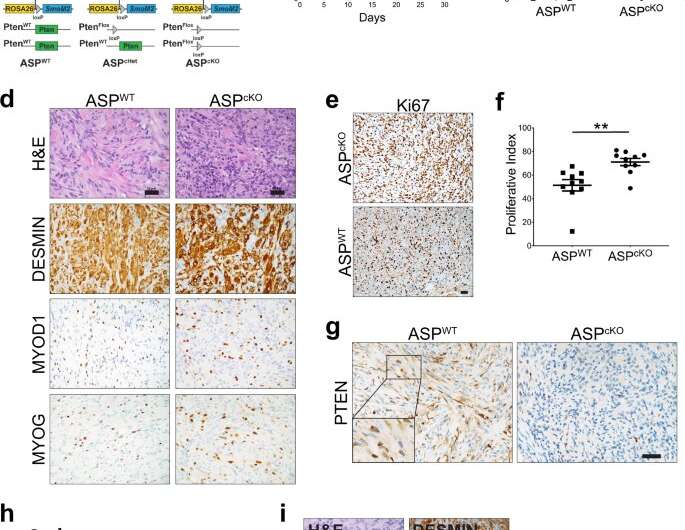Fig. 1: Pten loss exacerbates aP2-Cre;SmoM2 FN-RMS development. a Breeding strategy to generate ASPWT, ASPcHet, and ASPcKO mice. b Kaplan–Meier tumor-free survival in ASPWT (n = 23), ASPcHet (n = 42), and ASPcKO (n = 18) tumors (P < 0.0001). c Tumor mass at P12 from ASPWT (n = 11) and ASPcKO (n = 12) mice (P = 0.0052). d Representative histology of ASPWT (n = 16) and ASPcKO (n = 16) tumors by H&E and IHC staining for DESMIN, MYOD1, and MYOGENIN (MYOG). Scale bar, 25 μm. e, f Representative Ki67 IHC (e) and quantitation (f) in ASPWT (n = 9) and ASPcKO tumors (n = 7) tumors (ten random fields of view per genotype) (P = 0.0029). Scale bar, 25 μm. g Representative PTEN IHC in ASPWT (n = 3) and ASPcKO (n = 3) tumors. Scale bar, 25 μm. h Kaplan–Meier tumor-free survival curve of subcutaneous flank allografts of ASPWT (n = 11) and ASPcKO (n = 7) tumors (P < 0.0001). i Representative histology of ASPcKO (n = 3) allografts by H&E staining and IHC for DESMIN, MYOD1, and MYOG. Scale bar, 25 μm. All pairwise comparisons determined by unpaired, two-tailed Student’s t test. Kaplan–Meier survival curves analyzed with Mantel–Cox log-rank test. **P < 0.01, mean ± SEM. Credit: DOI: 10.1038/s41467-021-25829-4
Scientists at St. Jude Children's Research Hospital have revealed how the tumor suppressor gene PTEN plays a more important role in pediatric rhabdomyosarcoma than was previously appreciated. The research highlights a possible new treatment approach.The study appears today inNature Communications.
In this study, researchers showed that decreased expression of PTEN makes tumors more aggressive. The work also revealed that PTEN controls transcription factors such as PAX7 to govern rhabdomyosarcoma cell identity. Research findings also showed that loss of PAX7 was associated with tumor cell death, suggesting the protein as a potential treatment target.
Rhabdomyosarcoma is a type of soft tissue cancer that resembles skeletal muscle. It is the most common type of soft tissue sarcoma in children. Most cases of rhabdomyosarcoma occur in children younger than 10 years, and some children are even born with it.
Rhabdomyosarcoma either has a fusion oncoprotein (when two genes come together abnormally and create problematic proteins) with PAX3-FOXO1 or PAX7-FOXO1 or is fusion-negative. Fusion-negative rhabdomyosarcoma is genetically diverse, and sequencing has not found a particular driver mutation.
"We're fundamentally interested in how normal developmental processes are hijacked to turn on cancer in children," said corresponding author Mark Hatley, M.D., Ph.D., St. Jude Department of Oncology. "By knocking out PTEN in our mouse model, we generated tumors that more faithfully recapitulate the rhabdomyosarcoma that kids get by introducing this abnormality that spans the majority of tumors."
Transcription factors as a vulnerability for therapy
By looking at methylation data, how much (or little) certain genes are expressed, research by others found that decreased expression of the tumor suppressor gene PTEN is common in fusion-negative rhabdomyosarcoma.
"When we looked in the tumor cells of our wildtype model, we found PTEN mostly in the nucleus, which is not where we expected it to be," Hatley said. "That suggested to us that PTEN was contributing in transcriptional control and gene regulation."
Hatley and his team focused on the relationship between PTEN and two transcription factors—DBX1 and PAX7. The researchers found high expression of DBX1, which has never before been linked to cancer. They also found high expression of PAX7, which plays a known role in normal skeletal muscle development. They showed that PAX7 is involved in regulating and activating DBX1.
The researchers found that deleting Pax7 with PTEN alters the cell's identity, how a cell knows what it is and how to behave. Scientists observed a change in cells from skeletal muscle to smooth muscle.
The findings show that in addition to PTEN loss causing a more aggressive tumor, enhancing PAX7 expression PTEN loss maintains rhabdomyosarcoma cell identity.
"This work shows how genetically modified mouse models can provide insights into how different tumor suppressors can alter the dynamics of tumor initiation," said first author Casey Langdon, Ph.D., St. Jude Department of Oncology. "Our findings show that PTEN is not only in the nucleus controlling gene expression, it actually dictates the fate of the tumor cell in rhabdomyosarcoma, it's critical for maintaining tumor cell identity."
"When we looked at human rhabdomyosarcoma cells, and took out PAX7, the cells died," Langdon added. "This PTEN–PAX7 relationship is completely required for maintaining their existence."
These findings highlight how PAX7 may have a potential role as a molecular target for treating rhabdomyosarcoma as therapeutics-based transcription factors become available.
More information: Casey G. Langdon et al, Synthetic essentiality between PTEN and core dependency factor PAX7 dictates rhabdomyosarcoma identity, Nature Communications (2021). DOI: 10.1038/s41467-021-25829-4
Journal information: Nature Communications
Provided by St. Jude Children's Research Hospital
























